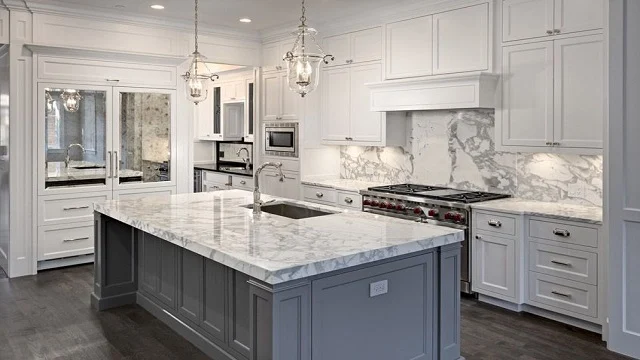Marble
I believe it is safe to assume that almost every homeowner has at some point or another heard about marble countertops. This has been a top design option to get that contemporary, sumptuous feel for decades.
When limestone or dolomite is exposed to intense pressure within the Earth's crust, marble is naturally created. The imperfections created by this process are what give marble its enormous variety of hues and patterns.
Even while this is fantastic, marble is not as durable as the other materials on our list. If you don't periodically protect it, it is also prone to stains as well as chipping, scratching, and etching. For new countertops, marble is a fantastic material, but handle with care!
Favorite Marbles a number of marbles are mentioned, such as Carrara marble, Calacatta marble, Calacatta Oro, Calacatta Extra, and Calacatta Borghini.
Quartzite
Due of its eerie veining, quartzite may have an uncanny resemblance to marble. Quartzite has created an outstanding name for itself in recent years, becoming more and more popular. It offers a great mix between beauty, toughness, and sustainability. Quartzite is far more durable and thick than marble and dolomite, making it less prone to discolor, scratch, or chip.
PS: Be careful not to mix quartz with quartzite! When quartz sandstone is exposed to high pressure and temperatures, quartzite is a naturally occurring metamorphic rock that forms. Quartz is a created stone, on the other hand.
Taj Mahal, Mercury White, White Macaubas, and Bianco Superiore are well-known quartzites.
Dolomite
Dolomite is a lesser-known sedimentary rock that develops when limestone meets groundwater that is rich in magnesium. It typically comes in white or gray tones with lovely streaks that more closely resemble marble than quartzite. Dolomite is tougher than marble and more resistant to chips and scratches, yet it is not as hard as granite.
The only significant drawback is that dolomite doesn't have as much color variation as its companion stone rivals, and it needs to be sealed frequently to stay in good condition. Fantasy Brown, Canyon Dawn, and Super White are well-known dolomites.
The Distinction Between Marble and Dolomite
Dolomite is a sedimentary rock distinguished by its distinctive white and gray appearance. It is produced when limestone and lime mud combine with magnesium-rich groundwater. This natural stone has distinctive qualities that set it apart from all others, despite frequently being mistaken for marble or quartzite.
Without further ado, let's compare the two stones in a few categories to examine the differences between marble and dolomite. You could discover that marble or dolomite are more appropriate materials for your design project.
Strength and Durability
Due in great part to its thick mineral makeup, dolomite is more durable than marble. Dolomites are a little bit harder than other marbles and are more resistant to heat and scratching. The density and durability of granite and quartzite are better than this stone, but not quite. In terms of durability, it's a decent middle-of-the-road alternative for kitchen and bathroom remodeling projects.
Scheme of colors
Dolomite is often gray, white, or tan in tone, making it a perfect choice for designing a posh interior. It occasionally appears with hints of pink, brown, black, or green. Dolomite often has a streaked pattern resembling several popular marble kinds. Dolomite has the opulent appearance of marble that homeowners who hanker after, with the important plus of being less delicate and more durable, all at a relatively cheaper price range.
Maintenance and Durability
A dolomite countertop will provide a long and attractive lifespan with proper maintenance, frequently outlasting marble over time. Dolomite can often endure liquids & acids more successfully than marble over time due to its higher amount of non-porosity. However, this stone requires some upkeep. To maintain its spotless appearance, it does need sealing frequently.
Affordability
Dolomite typically costs less than other sought-after marbles and other expensive stones, such quartz and granite. But bear in mind that costs will differ based on the precise application and the stone kind you choose.

